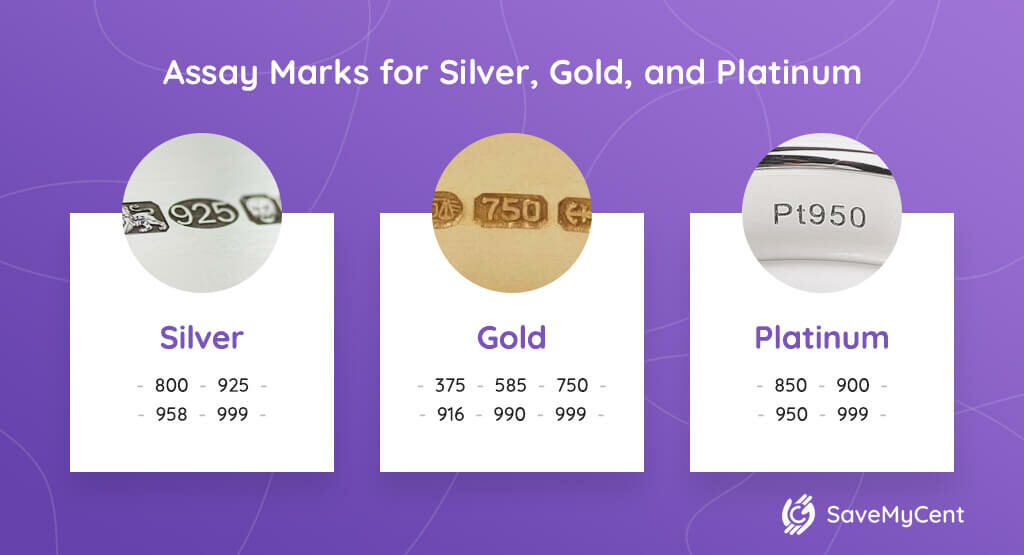This article will help you finally understand everything there is to know about jewelry stamps and what they mean. After reading this piece, you’ll be able to decode these cryptic symbols and immediately know how a piece of jewelry was made, and by whom.
Below, you’ll find everything you need to know about the meaning behind the most common stamps for gold, platinum, and silver jewelry, as well as some of the most widespread manufacturer stamps. Let’s dive in!
How Do I Identify My Jewelry Markings?
Identifying jewelry markings is a piece of cake. Let’s look at some of the most common stamps out there.
Sterling Silver Stamps (.925, 925, Ster)
These three markings denote that a piece of jewelry is made out of Sterling silver, which means the item is composed of 92.5% silver and 7.5% other materials, usually copper.
Jewelers prefer Sterling silver over pure silver because it’s more durable and less soft, which helps the piece maintain its shape and luster throughout the years.
Sometimes, you may find a letter following the stamp. These symbols stamped on jewelry are manufacturer marks which show who made that piece.
Karat Marks (10K, 14K, 18K, 24K)
Karats are a unit of purity and help you determine how pure a specific piece of gold jewelry is.
Here’s how they work: one gold karat equals 1/24th of the whole piece of jewelry. For example, a necklace made out of 10 parts gold and 14 parts copper is made out of 10-karat gold. These gold identification marks on jewelry first started being used back in 1873.
- 10K means ten karats and indicates that a piece of jewelry is 41.6%, or 10 out of 24 parts gold. The remaining parts could be copper, nickel, zinc, or silver.
- 14K stands for 14 karats and gets stamped on pieces of jewelry composed of 58.3% pure gold. It’s the most commonly used gold.
- 18K is 18 karats, or 75% pure gold.
- 24K is 24 karats, which means that the piece of jewelry is made entirely of pure gold.
Assay Marks for Silver, Gold, and Platinum
Assay marks can take the form of numbers engraved inside a ring or on any other piece of jewelry. They’re another way to assess the purity of a particular material, and stand for the purity percentage. For example, a gold ring stamped with 750 is 75% pure.
An assay office must always approve these stamps, and you can often find them on English-made pieces of jewelry.
These are the assay stamps for silver:
- 800
- 925
- 958
- 999
These are the assay stamps for gold:
- 375
- 585
- 750
- 916
- 990
- 999
These are the assay stamps for platinum:
- 850
- 900
- 950
- 999

Most Common Platinum Stamps
Let’s take a look at the most common stamps on platinum jewelry.
They are Plat 900, 900 Platinum, 900 Plat, Pt900, and 900pt. These marks all denote that an item is made out of 90% platinum and 10% other materials, most commonly rhodium, palladium, or ruthenium.
American Tungsten Marks (TE USA)
Recently, jewelers started using tungsten for manufacturing pieces of jewelry. To identify certified tungsten pieces, look for an engraving that reads TE. If the item was manufactured in the United States, you would also find a USA mark.
Stainless Steel Marks (S.S, St. Steel)
If you’re out buying jewelry and have sensitive skin, you may want to look out for these stamps. They denote pieces of jewelry made out of stainless steel, a hypoallergenic, inexpensive, and durable material.
Antique Symbols Stamped on Jewelry
To identify antique pieces, jewelers came out with several markings, beginning with the letter A, which stands for antique, and followed by two other letters, which describe the plating or finish.
These are the most common antique stamps found on pieces of jewelry:
- ARP: Antique rhodium-plated
- ANP: Antique nickel-plated
- ACP: Antique copper-plated
- ABP: Antique brass-plated
- AGP: Antique gold-plated
- ASP: Antique silver-plated
- ARF: Antique rhodium finish
- ACF: Antique copper finish
- AGF: Antique gold finish
- ASF: Antique silver finish
Platnaire Stamps (Sk9)
An Sk9 stamp denotes that a piece of jewelry is made out of Platnaire, a patented hypoallergenic alloy of platinum (5%), Sterling silver (92.5%), and other undisclosed elements (2.5%).
Palladium Markings (PD)
PD is a precious metal identifier found on pieces of jewelry made out of palladium, a platinum alloy.
Gold Plating and Bonding Stamps (GE, GP, GF, HE)
GE, GP, and GF stamps signify gold bonding or plating. GE stands for gold electroplated, while HE means that the item is heavy gold electroplated.
GP means gold plated, and it’s one of the most commonly found stamps on affordable jewelry.
GF denotes gold bonding, which means that the piece of jewelry presents a layer of gold bonded to a less expensive base metal. You can often find this mark on watches.
Other Gold Marks (WGD, KP)
WGD indicates weighted gold. A karat marking can follow it.
KP stands for karat plumb and means that a material is of a particular karat or higher. For instance, 14KP implies purity of at least 14 karats.
Iron Plating Marks (IP)
If you’re shopping for some work tools or a knife, you should always look for an IP mark, which means that the item is iron-plated, a technique that dramatically improves durability. It’s possible to find this stamp on pieces of jewelry.
Pandora Markings
You can quickly identify Pandora pieces of jewelry through the ALE mark engraved on all pieces manufactured by the company.
Jewelry Stamps and What They Mean: FAQ
1. What Do the Numbers on Jewelry Mean?
Numbers found engraved on jewelry usually determine the purity of the material.
If you find a three-digit number, it’s an assay mark, and it simply means how pure, in percentage, the piece of jewelry is. For example, a silver ring engraved with 925 means 92.5% pure silver.
A two-digit number followed by K indicates karats. You can find it on gold jewelry, and the number cannot be higher than 24.
2. What Does the Stamp on My Ring Mean?
Stamps on a ring can tell you how a ring was made, who made it, when, with which materials, and its purity. Why don’t you look above and see if you can spot any of the marks found on your ring?
Should your ring be marked with letters or numbers that we didn’t mention, we highly suggest bringing it to a local jeweler.
3. What Does LACN Mean on Jewelry?
First of all, you’re looking at two different markings: LA and CN.
The first one, LA, stands for Sterling silver, which means your piece of jewelry is 92.5% pure silver. That’s good, because Sterling silver is a high-quality and valuable material.
The stamp CN means that the product is from China. Don’t be alarmed: this doesn’t automatically mean that it’s a poorly crafted product. In fact, according to the latest jewelry industry statistics, China is the world’s top producer of jewelry.
So, if your ring, necklace, or watch has an engraving that reads LACN, it just means that you’ve got your hands on a Sterling silver item made in China.
4. What Is the Number for Gold?
As we mentioned before, the purity of a gold product is usually indicated on the item itself in two ways: with karats (2 digits followed by a K) or assay stamps (three digits without any letters). These measurements refer to the same thing.
If you find an assay stamp, just divide the three-digit number by 10, and you have the purity of the gold in the form of a percentage. The most common assay stamp is 585.
If you find karats instead and want to know the quantity of gold in your piece of jewelry, just take the number you found, multiply it by 24, and divide it by 100. For example, 18K gold is 75% pure.
5. How Do Platinum Markings Look?
Purity markings on platinum products are easy to distinguish from those for other materials. They look like a three-digit number encased in a five-sided shape, which resembles a tiny house.
Pure platinum jewelry has to be at least 50% pure, which means there can’t be a number lower than 500 stamped on platinum jewelry. The most common purity stamps for platinum are 850, 900, 950, and 999.
6. What Is the Symbol for Silver on Jewelry?
Similar to platinum products, items made out of silver also can be easily identified through a three-digit mark. However, the digits are inside an ellipse instead of a house-like shape in this case.
The most common number found on silver jewelry is 925, identifying Sterling silver. Other typically found numbers are 800, 958, or 999.
7. How Are White Gold Symbols Stamped on Jewelry?
White gold symbols look the same as gold ones, which helps us discern between similar-looking white gold and platinum products.
As we mentioned before, platinum hallmarks look like three digits encased in a house-like shape, always followed by the letters PT, Pt, or Plat.
White gold pieces of jewelry get a different hallmark. It looks like an eight-sided ingot with three digits inside. You might also find a karat stamp, which indicates that you’re looking at a white-gold item.
8. What Does the 950 Stamp on Jewelry Mean?
If you find a 950 stamp on your jewelry, the item in your hands is 95% pure. The number alone doesn’t tell you the material of the product.
If you find the digits inside an ellipse, it’s silver. An eight-sided ingot indicates gold. If they’re inside a house-looking shape, it’s platinum.
950 hallmarks are also commonly found on palladium jewelry. If your item is from before 2009, you’ll find the three digits engraved inside a four-sided ingot. Any palladium item made after 2009 will have its fineness hallmark stamped inside three conjoined ellipses in a shape similar to a caterpillar.
Conclusion
So many shapes, so many letters and numbers on gold and silver jewelry! It looks like high-school algebra all over again.
As you can see, the number of hallmarks you can find on precious items is vast. However, knowing the quality and material of your pieces of jewelry would be almost impossible without these identification marks stamped inside rings and other pieces of jewelry.
Did you discover anything new about your jewelry thanks to these stamps? We hope so. If you still have doubts, don’t hesitate to contact a qualified jeweler near you—they’ll surely help you.







![How to Get Free Clothes From Shein? [2024 Guide]](https://savemycent.com/wp-content/uploads/2023/09/How-to-Get-Free-Clothes-From-Shein-336x220.png)
